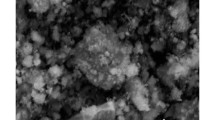Abstract
The products of solid-phase mechanochemical interaction between pyrocatechol and silicon dioxide yielding a powdered composite were studied using a number of physicochemical methods. This interaction is shown to give rise to surface complexes via the reaction of silanol groups and other active sites on the silicon dioxide surface with the hydroxyl group of pyrocatechol. The interaction efficiency increases with rising number of surface hydroxyl groups. The hypotheses regarding the possible mechanisms for this reaction are put forward. The potential surface complex species (intermediates) that play a decisive role in obtaining of soluble chelate complexes of silicon by adding water to the composites are proposed. Obtaining the composites that contain surface complexes is an efficient method to enhance the silicon dioxide solubility due to complexation.
Similar content being viewed by others
References
Huang GL, Liu Y, Chen L (2017) Chitosan and its derivatives as vehicles for drug delivery. Drug Deliv https://doi.org/10.1080/10717544.2017.1399305
Kortesuoa P, Aholab M, Karlssona S, Kangasniemi I, Yli-Urpo A, Kiesvaara J (2000) Silica xerogel as an implantable carrier for controlled drug delivery – evaluation of drug distribution and tissue effects after implantation. Biomaterials https://doi.org/10.1016/s0142-9612(99)00148-9
Finnie KS, Waller DJ, Perret FL, Krause-Heuer AM, Lin HQ, Hanna JV, Barb CJ (2009) Biodegradability of sol–gel silica microparticles for drug delivery. J Sol-Gel Sci Technol https://doi.org/10.1007/s10971-008-1847-4
Lu J, Liong M, Li Z, Zink JI, Tamanoi F (2010) Biocompatibility, biodistribution and drug-delivery efficiency of mesoporous silica nanoparticles for cancer therapy in animals. Small https://doi.org/10.1002/smll.201000538
Barbé C, Bartlett J, Kong L, Finnie K, Lin HQ, Larkin M, Calleja S, Bush A, Calleja G (2004) Silica particles: a novel drug-delivery system. Adv Mater https://doi.org/10.1002/adma.200400771
Lomovsky IO (2012) Stability of green tea catechins in the solid phase and aqueous solutions chemistry for. Sustain Dev 20:215–220
Colombo I, Grassi G, Grassi M (2009) Drug mechanochemical activation. J Pharm Sci https://doi.org/10.1002/jps.21733
Shakhtshneider T, Myz SA, Mikhailenko MA, Drebushchak TN, Drebushchak VA, Fedotov AP, Medvedeva A, Boldyrev VV (2009) Mechanochemical synthesis of nanocomposites of drugs with inorganic oxides. Mater Manuf Process https://doi.org/10.1080/10426910902979124
Watanabe T, Hasegawa S, Wakiyama N, Kusai A (2003) Comparison between polyvinylpyrrolidone and silica nanoparticles as carriers for indomethacin in a solid state dispersion. Int J Pharm https://doi.org/10.1016/S0378-5173(02)00549-5
Damm C, Peukert W (2009) Kinetics of radical formation during the mechanical activation of quartz Langmuir https://doi.org/10.1021/la803502x
Watanabea T, Hasegawaa S, Wakiyamaa N, Usui F, Kusai A, Isobe T, Senna M (2002) Solid state radical recombination and charge transfer across the boundary between indomethacin and silica under mechanical stress. J Solid State Chem https://doi.org/10.1006/jssc.2001.9436
Vorsina IA, Grigorieva TF, Barinova AP, Lyakhov NZ (2011) Mechanochemical interaction of silicon dioxide with organic acids. Chem Sustain Dev 19:447–455
Ikekawa T, Hayakawa S (1991) The grinding-aid effect of phenylalanine on talc powder. J Soc Powder Technol 28:544–549
Iler RK (1979) The chemistry of silica: solubility, polymerization, colloid and surface properties and biochemistry of silica. Wiley, New York
Bernstein T, Mastikhin V, Shubin AA, Fink P (1986) High-resolution solid-state magic angle spinning nuclear magnetic resonance investigations of surface hydroxy groups on modified silica gel. J Chem Soc Faraday Trans 82:1879–1884
Acknowledgments
This study was supported by the Russian Science Foundation (grant no. 16-13-10200).
Author information
Authors and Affiliations
Corresponding author
Additional information
Publisher’s Note
Springer Nature remains neutral with regard to jurisdictional claims in published maps and institutional affiliations.
Rights and permissions
About this article
Cite this article
Trofimova, E.G., Lomovsky, O.I. The Mechanism of Mechanochemical Interaction between Amorphous Silicon Dioxide and Pyrocatechol. Silicon 13, 433–439 (2021). https://doi.org/10.1007/s12633-020-00444-y
Received:
Accepted:
Published:
Issue Date:
DOI: https://doi.org/10.1007/s12633-020-00444-y



